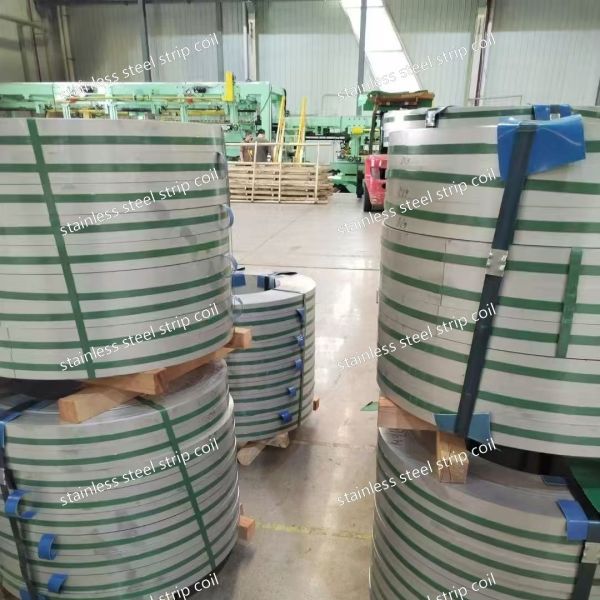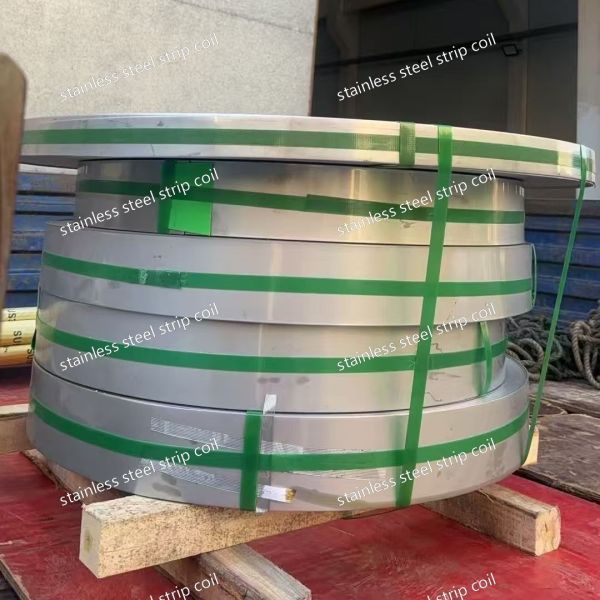Stainless Steel Strip Coil Alloy SUS304 SUS316L SUS321 SUS430
Narrow SS Strips Width 5 - 50mm
Products Specification
| Product Name | Stainless Steel Strips |
| Length | As required |
| Width | 3mm-1219mm or as required |
| Thickness | 0.15 - 3.0mm or as required |
| Standard | AISI,ASTM,DIN,JIS,GB,JIS,SUS,EN,etc. |
| Technique | Hot rolled / cold rolled |
| Surface Treatment | 2B or according to customer requirement |
| Thickness tolerance | ±0.01mm |
| Material | 201, 202, 301, 302, 303, 304, 304L, 304H, 310S, 316, 316L, 317L,
321,310S 309S, 410, 410S,420, 430, 431,434, 440A,904L,2205,2507 |
| Application | It is widely used in high temperature applications, medical
devices, building materials, chemistry, food industry, agriculture,
ship components.It also applies to food, beverage packaging,
kitchen supplies, trains, aircraft, conveyor belts, vehicles,
bolts, nuts, springs, and screen. |
|
| MOQ | 1tons.We also can accept sample order. |
| Shipment time | Within 15-20 workdays after receiving deposit or L/C |
| Export packing | Waterproof paper, and steel strip packed.Standard Export Seaworthy
Package.Suit for all kinds of transport,or as required |
|
| Capacity | 250,000 tons/year |
Stainless steel strip is a versatile and widely used form of
stainless steel, characterized by its thin, flat structure and
exceptional mechanical and chemical properties. It is produced
through a series of precision manufacturing processes, making it
suitable for diverse applications across industries ranging from
automotive to electronics, construction to medical devices.
What is Stainless Steel Strip?
Stainless steel strip, also known as stainless steel ribbon, is a
rolled metal product with a width typically ranging from a few
millimeters to several hundred millimeters, and a thickness as thin
as 0.01mm up to around 3mm. Its defining feature is the presence of
chromium (at least 10.5% by weight), which forms a passive oxide
layer on the surface, providing excellent corrosion resistance.
This oxide layer self-heals when damaged, ensuring long-term
durability even in harsh environments.
Manufacturing Process
The production of stainless steel strip involves several key steps
to ensure precision and quality:
- Melting and Casting: Raw materials such as iron ore, chromium,
nickel, and other alloying elements are melted in electric arc
furnaces. The molten metal is then cast into slabs or billets.
- Hot Rolling: The slabs are heated and rolled into thinner sheets
called "hot-rolled coils," reducing thickness while improving
mechanical properties.
- Cold Rolling: Hot-rolled coils undergo cold rolling to achieve the
desired thickness, surface finish, and dimensional accuracy. This
process also enhances strength and hardness.
- Annealing: After cold rolling, the strip is annealed in a
controlled atmosphere to relieve internal stresses and restore
ductility. Annealing temperatures typically range from 800°C to
1100°C, depending on the stainless steel grade.
- Surface Treatment: Various surface finishes are applied, including
2B (matte), BA (bright annealed), and polished, to meet specific
application requirements.
- Slitting and Cutting: The final coils are slit into strips of
precise widths using advanced slitting machines, ensuring tight
tolerances.
Types and Grades
Stainless steel strips are classified based on their crystalline
structure, with the most common types being:
- Austenitic: The most widely used type, containing high levels of
chromium and nickel (e.g., 304, 316). These strips offer excellent
corrosion resistance, formability, and weldability, making them
ideal for food processing, chemical equipment, and decorative
applications.
- Ferritic: Contains chromium but little or no nickel (e.g., 430).
They are magnetic, cost-effective, and suitable for applications
like automotive trim and kitchen appliances.
- Martensitic: Hardenable by heat treatment, with high strength and
wear resistance (e.g., 410). Used in cutlery, valves, and
mechanical components.
- Duplex: Combines austenitic and ferritic structures (e.g., 2205),
offering high strength and corrosion resistance for oil and gas,
marine, and structural applications.
Key Properties
Stainless steel strip boasts a unique set of properties that make
it indispensable in various industries:
- Corrosion Resistance: The chromium oxide layer protects against
rust and chemical attack, even in humid, acidic, or salty
environments.
- Strength and Durability: Cold rolling enhances tensile strength,
allowing the strip to withstand mechanical stress and heavy loads.
- Heat Resistance: High-temperature grades (e.g., 310) retain their
properties at temperatures exceeding 800°C, suitable for furnace
parts and exhaust systems.
- Formability: Easily bent, stamped, or welded into complex shapes
without compromising integrity, enabling versatile design
applications.
- Hygiene: Non-porous surface prevents bacterial growth, making it
ideal for medical equipment, food processing, and pharmaceutical
machinery.
Applications
The versatility of stainless steel strip is reflected in its wide
range of applications:
- Automotive Industry: Used in exhaust systems, fuel lines, and
decorative trim due to heat and corrosion resistance.
- Electronics: Precision strips serve as connectors, battery
components, and shielding in smartphones, computers, and electrical
devices.
- Medical Devices: Biocompatible grades (e.g., 316L) are used in
surgical instruments, implants, and diagnostic equipment.
- Construction: Applied in roofing, cladding, and structural
components for its durability and aesthetic appeal.
- Household Goods: Found in kitchen utensils, appliances, and
hardware for its hygiene and sleek finish.
Advantages Over Other Materials
Compared to carbon steel, aluminum, or plastic, stainless steel
strip offers distinct advantages:
- Longer service life due to corrosion resistance, reducing
replacement costs.
- Higher strength-to-weight ratio, enabling lightweight yet robust
designs.
- Recyclability: Over 90% of stainless steel is recyclable, making it
an eco-friendly choice.
- Low maintenance: Requires minimal cleaning and upkeep, even in
demanding environments.









 Quality Bright Anneal Finishing 301 / 304 Stainless Steel Strip 1/4H 1/2H 3/4H FH SS Strips wholesale
Quality Bright Anneal Finishing 301 / 304 Stainless Steel Strip 1/4H 1/2H 3/4H FH SS Strips wholesale
 Quality Alloy 926 / 1.4529 Super Stainless Steel Strips Coils, Width 0.3-8.0mm, SA240 Standard wholesale
Quality Alloy 926 / 1.4529 Super Stainless Steel Strips Coils, Width 0.3-8.0mm, SA240 Standard wholesale
 Quality SUS301 Stainless Steel Strip / Stainless Steel Tape Soft Type / Hard Type SS Roll wholesale
Quality SUS301 Stainless Steel Strip / Stainless Steel Tape Soft Type / Hard Type SS Roll wholesale